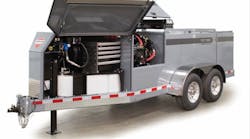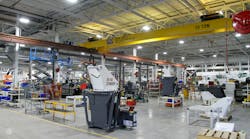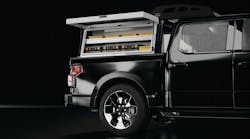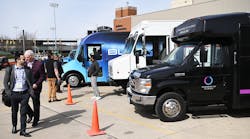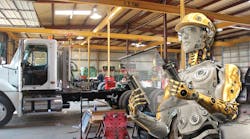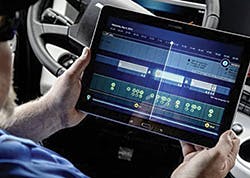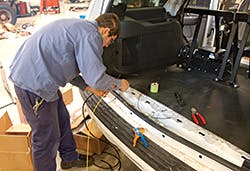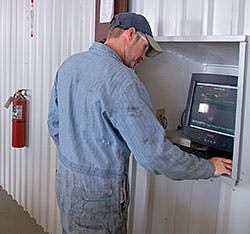In 1899, Walter A Messer started W A Messer Co—a one-man blacksmithing and shipsmithing shop on Union Street in Portland, Maine.
The focus has changed over the years: to the manufacture of open-sided delivery truck bodies, furniture vans, and general van body equipment in the early 1900s with the advent of motor vehicles; to manufacturing custom truck bodies in the late 1940s; then the addition of trailer maintenance and repairs a few years later; and finally becoming more of a multi-line truck equipment distributorship in the 1970s.
The leadership has changed: Jack Messer became president in 1957 when his father retired at 78 years old; and Jeffrey W Messer, great-grandson of Walter joined the company in 2003, becoming the fourth generation in the family business, and took over as president when his father, John, died, and later purchased the business.
The name has changed: In 2004, it was changed to Messer Truck Equipment.
But the shop hasn’t changed dramatically, despite many technological changes in the equipment those shops deal with—something Jeff notices about most truck equipment distributors.
“I don’t think the American shop has changed much in the past 30-plus years,” he said. “As the fourth generation to run my family’s business, I’ve seen very little change in the shop setup or tooling dating back to my time visiting the shop as a child.
“In recent history, there has been a massive amount of change in the vehicle electronics. With the advent of onboard vehicle computers, it has completely changed the way that truck-mounted equipment interfaces with the chassis. It started with LED lights and blinkers ‘quick flashing’ and now the wiring systems are so sensitive that some truck-mounted equipment is not working as it was designed. Upfitters now have to work closely with the truck dealers and the OEMs to ensure the equipment is properly integrated with the chassis.”
Massive changes are coming to shops, and Messer has been preparing for them.
To get a handle on the Shop of the Future, Trailer/Body Builders talked with industry experts and a sampling of truck equipment distributors from different areas of the country. Here’s what we found:
• What will the Shop of the Future look like?
Shawn Jacobs, president/CEO, STS Truck and Trailer Equipment, Syracuse, New York: “A major change in the last five to seven years has been with regard to available electronics and their application to our industry, which will just continue to expand. No different than the smartphone we all carry today that only a few years ago worked to only take calls, then text and email, and now can run a company. We will see more application for that technology and application to our industry. Will it continue to evolve as fast as it has in the last five to seven years? Probably, but I also anticipate adding new apps to my phone in order to have an easier way to accomplish the desired result.
“I believe prior to this change, the last 30 years consisted of better materials, better builds both at factory and upfitter levels, but nothing as significant with regard to technology gains as I mentioned. What the future will hold for technology and application to our shops I think will for the most part be limited to this aspect of our products and installations.
“With the changes in the direction of the traditional distribution model for most upfitters, I believe the Shop of the Future may be a smaller shop, but with a much larger focus on specialization. Unless a truck equipment distributor has a chassis pool, the days for the ‘cookie cutter’ builds have diminished. On the other hand, building single, high-spec’d trucks has grown significantly.”
Mark Martincic, professional advisor and director of fixed operations training and consulting for KEA Advisors, Lawrence, Kansas: “Technology obviously has driven change in diagnostics and overall quality of vehicles. But technology has also drastically changed how we interface with customers. OEM vehicle technology will continue to improve with self-driving vehicles, safety technology, communication technology from the vehicle to the owner and vehicle to the repair facility. Shops will need to embrace both forms of technology to survive, and history has shown a reluctance to change in most repair facilities in the past.”
Ray Grapsy III, dealer management consultant, American Truck Dealers’ 20 Groups, Tysons, Virginia: “There has been an evolution of technology in the service departments that has already been incorporated in the infrastructure of most shops. Shops have already made the investment in computer infrastructure and wireless technologies. The change in the next five to 10 years will deal with customer interaction, customer experience, and improving efficiency. This change will manifest itself when facilities are constructed or remodeled and when new processes are introduced into the business model. The vehicle has already been upgraded with numerous technologies, and those technologies will continue to evolve and expand within the same communication platform that is available today.
“I think the wild card is the vehicle-to-vehicle communication of autonomous trucks and the security that will be required in that communication platform. Again, the major changes in the near future will be to drive efficiency through the system and provide a higher level of customer support. I think the change has been and will continue to be evolutionary rather that revolutionary. Communication platforms used by the dealership to ‘talk’ to the vehicle are stable. The price of technology hardware has been coming down relative to where it was a decade ago. Technology will continue to evolve and become more complex but at a manageable rate. While technological investment will continue, additional investment in infrastructure will take place with the goal of improving shop and technician efficiency. Depending upon the footprint available, the facility of the future will be larger, more open, incorporate technician support in centralized areas, whether that support be parts, tooling and equipment, and/or management support.”
Steve Carey, executive director, National Truck Equipment Association (NTEA), Farmington Hills, Michigan: “The future will bring increased reliance on technology and Lean principles on the shop floor and even into the front office. The use of technology and modern fabrication techniques will be increasingly accessible by both large and smaller companies. The emphasis will be on using technology, Lean thinking, and effective use of human capital to improve overall productivity.”
Ron Slee, managing director of Learning without Scars LLC, Rancho Mirage, California: “You’re going to deliver parts with drones to the bay from the parts department, so my physical plant can be designed differently.”
• What trends do you see?
Slee: “I’d guess within five years we’ll have city-to-city driverless tractor trailers going places in the middle of the night, meaning there will be a lot more predictability. A computer driving a vehicle is much less damaging on the vehicle itself.
Jacobs: “Greater hours per build but fewer builds.”
Doyle Sumrall, managing director, NTEA: “There will be continued focus on quality and productivity. Returns and rework are disruptive and expensive for both the vehicle purchaser and the upfitting facility. Shops will continue to build quality checks into their normal processes and strive for efficiency through elimination of waste and more efficient utilization of time.”
Martincic: “Customers have access to more information than ever regarding their vehicle. As a result, customers will have the ability to demand more personalized service. Shops will need to know customers preferences. Demand for mobile service will grow. Customers will want constant communication (live status) regarding their trucks, along with accurate time and cost estimates.”
Messer: “Companies are embracing Lean principles to help identify waste. I’m seeing the use of tablets to capture forms and perform research.”
Grapsy: “Trends are to have the technicians on the service floor being productive and efficient. This involves moving parts support from a traditional ‘back counter’ to the shop floor, many times alongside of the service foreman or service adviser office. Parts delivery directly to the technician in his or her bay is also a time-saving, production-boosting strategy being employed at a growing number of dealerships.
“Larger dealers incorporate a ‘quality control’ driver to perform test drives and be a porter moving trucks in and out of the repair bay. Centralizing restroom facilities and special tool storage in a shop also cuts down on wasted time. Allowing a technician to work out of multiple bays is another trend aimed at keeping the technician productive and eliminating any downtime moving vehicles while waiting for parts, customer approvals, etc.
“Electronic communication platforms will enable service advisers to provide accurate repair estimates to service customers in a more efficient manner adding to a technician’s individual as well as the shop’s overall efficiency. Technician pay plans will migrate to becoming more variable and productivity-based rather than hourly-based. Dealers will become involved with managing customer vehicle service needs, including breakdowns, as customers demand real time updates and up-time.”
• How will staffing needs be met?
Slee: “We’ve got a shortage of labor to go into the shop, so the composition of skills is going to change. We’re going to have fewer people with high skills, more people with low skills. So the density of supervision on the floor will change. As I have fewer skilled people and a few skilled people, I have to leverage skills and apply them across more people. So instead of having a 1-to-8 ratio of supervision to mechanic, I might have a 1-to-6 maybe even 1-to-4, depending on what the skill set is. Which means my layout will be different, because I’m going to have two or three trucks in a bay, where that might not be the case today. I’m going to have one journeyman technician presiding over a bay that maybe has three rookies in it. Or maybe it’s two bays and I’ve got four rookies and one senior guy. The way engine people—Cummins, Detroit, etc—have looked at repairs is they do trouble shooting and repair as they go. That’s going to be changing, because we haven’t got the skill. So if I had a shop previously that was 12 people and they all knew what they were doing, that shop might end up having to have 24 people where maybe only eight know what they’re doing and the other 16 are led with very close supervision by the other eight. That’s going to put a profit challenge and system challenge on things, because I’m going to have to have variable labor rates according to the skills of the guys. Which means I’m going to have to use a lot more standard times. Those standard times are going to have to be degree-of-difficulty rated. I’m going to have more assessments of the technical skills of people, so I’m going to have specific task assessments so that George can do these 17 tasks well, and the degree of difficulty of those tasks is medium, using an arbitrary term. I can apply George to medium tasks, so my job code has to be split into hard, medium, and easy. Very few people have done that yet. Very few people have thought that way yet. I think that will be forced on shops. And that means that service management in the truck shops is going to have to become much more professional business management, as has been the case in the past technical management. You’ll still need a lot of technical skills, but will need a lot more business skills. I’m going to have to plan my shop or schedule my shop according to an availability of skills and availability that workload provides me with what skills I need to have with that particular task. And computer and business system technology is allowing us to get there. We can use drag-and-drop scheduling systems, but this will be embedded right into the business systems into CDK or ADP or Truck or those various software packages that are out there for the business systems.”
Jacobs: “The higher level of training required for the builds has meant we use our current techs and guide them to a greater level of sophistication. Due to the reduction in overall builds, it has somewhat mitigated our tech shortage issue, although not eliminated it nor addressed what will continue to be our biggest issue.”
Carey: “Many companies are beginning to take ownership of their labor pipeline through community outreach and make structural changes to assess areas such as compensation, employee training, benefits, and work environment. These changes are intended to help these organizations improve their competitive position for employees within their local markets. Such changes are not necessarily expensive and can be effectively scaled for large and small operations. Challenges with employee recruitment and retention are unlikely to be resolved in the foreseeable future.”
Martincic: “I believe the future technology in vehicles will attract younger computer-savvy technicians—those that love technology and programming. I also believe the OEMs are and have been focused on collecting data and final repair information from their dealers, which will result in drastically improved diagnostic and repair procedures. If the diagnostics become simpler and quicker, it will reduce the need for the highest skilled technicians.”
Messer: “Staff will need to be ‘home-grown.’ Individuals with the aptitude for learning will be hired and then educated and trained. The drought of skilled labor will continue and will force processes to be changed to continue to maintain the same or greater output with fewer human resources. Jobs will need to be standardized to allow for easier training of junior techs. Highly customized jobs will be limited or the price will increase to cover increasing wages.”
Grapsy: “This has become a true crystal-ball question. I think the answer depends upon how quickly the industry is able to adapt its HR model to the Millennial generation. The workforce by 2020 will be 50% Millennial, and by 2025 will be 75% Millennial. They outnumber Gen X by almost two to one. As a whole, Millennial concerns differ from the generations preceding them. They are diverse (43% non-white, 38% bilingual) and technology-dependent. They want to know how they fit in to and contribute to the organization. They are innovative and creative and demand to see a clear path of progress, not only personally but for the organization as well. The degree to which a dealer can evolve into a culture that supports a Millennial workforce along with the adaptation of that workforce to the realities of dealership operations will answer the staffing question. The money will be there, the jobs will be there, the technology will be there. Will the techs be there as well?”
• How will shop productivity and profitability be improved?
Slee: “We’ve got surgeons doing eye surgery where the surgeon is in Boston and the patient is in India. We’re going to be able to do the same kind of thing with engines ultimately. I’m not joking. Go out 10 to 20 years with artificial intelligence and robots—you’re going to have robots doing repairs on engines.”
Sumrall: “The focus on Lean is increasing, and process development and control are starting to be viewed as real solutions/possibilities for job shops. Companies are working with suppliers and other partners to eliminate dual effort and to have the work done by the most efficient party. Automation is a factor when possible, and process simplification will continue to be of importance.”
Martincic: “Improving performance is and always will be about training, setting specific achievable goals, enabling engagement from management, coaching, and accountability.”
Messer: “Productivity and profitability will be improved by utilizing Lean tools and encouraging all employees to practice continuous improvement. There is always a better way to do something, and management must trust all employees to find a better way. Productivity is also improved when waste is removed from the value stream. Waste is more easily identified when Lean tools are employed.”
Grapsy: “Shops that incorporate a pay plan based on productivity, support that plan with the trends I discussed, and use technology in customer communication, will be productive. Profits will improve as the products offered to customers meet or exceed expectations, processes are implemented to increase the amount of margin available, and expenses are controlled to minimize profit erosion. Efficiency and customer relationships will be co-monarchs.”
• How will management practices change?
Slee: “The guys that are running businesses today aren’t particularly respectful of the brains and needs and wants of the Millennials—the guys born in the mid-‘80s and after. And older guys like you and I typically don’t know how to deal with these younger guys. Some of us do. But they’re a lot smarter than we are, and a lot less patient than we are, and put up with less BS than we did. So you really need an environment where these people are challenged. They’re going to be paying our Social Security. So we have to figure out how to work with these guys, and I don’t think the generation currently running business is doing a good job of adapting to them. Today’s shop owners are risk-averse. They’ve got what they want. They know how to make money and don’t want to risk it. The problem is, you can’t do that. Time catches up with you. So the longer they wait, the more at risk they become. The longer they wait to adapt their business to the new reality, the more they put their business at risk. Because all of a sudden, when they need to do it, they have to do it in a year’s time, and it’s not something you can do in a year’s time.”
Carey: “In addition to Lean, there will need to be a renewed focus on how organizations recruit and retain human capital. How companies utilize and embrace employees is an important business consideration for today and into the future.”
Martincic: “Whether a dealer chooses Lean, Six Sigma or other approaches, the most successful management practices I have seen or been part of are always about developing an enabling work culture, setting clear, attainable goals, communicating those goals, and providing every team member with the specific roles they need to accomplish daily to achieve those goals.”
Messer: “I’m a firm believer in Lean principles, and I’m convinced that all companies need to embrace Lean to get to the next level.”
Grapsy: “Cross-training within a department and even between departments will enable the dealer to be lean as well as support a culture change necessary to attract and retain millennials. Managing ‘leading indicators’ versus reacting to financial statements will distinguish successful, lean, efficient dealers. Managing those leading indicators at the lowest level possible will distinguish the top performers.”
• How will companies market?
Jacobs: “We are finding that it is not taking long for many commercial and municipal accounts to be sharing via word of mouth where they had their upfits done, especially when the special build requirements were numerous. We are also finding our vendors are referring more and more of these inquiries to us.”
Martincic: “Social media, apps, or software for consumers that provide live communication regarding their vehicle’s needs, scheduling, costs, progress of repairs, etc. Constant availability of live status information.”
Messer: “Equipment will continue to be sold through truck dealers. In-person sales calls and relationships will continue to be important. Local and regional sales will continue to be important, but the lure of large national fleet deals will entice the larger upfitters.”
Grapsy: “Today, 83% of Millennials sleep with their phones, and they can retrieve information any time they want. Any organization that wants to reach that demographic of soon-to-be decision makers must make an impression via mobile technology.”
• How truck technology will impact truck equipment installation?
Slee: “I think the electronic control unit, the management of the engine to power the transmission. Then you put on top of that having a computer drive the vehicle. We’ve seen what happens with the computerization of engines and transmissions on other kinds of equipment where component life is extended tremendously. Twenty years ago, when we were talking about a million miles before we did an engine overhaul—that was blasphemy. But that happened and it changed the cost dynamic for the owner of the truck dramatically. We’re about to enter another one of those, and it will be another stair-step improvement.
”The life of the components—what happens to the manufacturer of engines where instead of an engine going 2.5 million miles before it has to be replaced, it goes five million? If politics doesn’t get in the way, we’ve got all kinds of manufacturers doing all kinds of things. The engine is better, the life is longer. See how many different things this opens up? On one side, it’s wonderful. But this industry hasn’t had those kinds of things hoisted on them. We’ve kind of been dinosaurs, haven’t we?”
Jacobs: “The electronic advancements and the complete integration of all the multi-function applications of these trucks will make it more and more challenging while trying to maintain committed installation and bid times. Each component may work well individually, but as soon as they are integrated, it is quite a challenge and time-consuming to finalize the installation to insure proper operation.”
Sumrall: “The acceleration of telematics and systems electrification will likely have the largest effect on upfitting in the near term. As the industry continues to work toward more productive commercial vehicles, the deployment of telematics, equipment integration into the vehicle and systems electrification for idle reduction will continue to increase. More lightweight and composite materials will become common over time. In the upfitting process, technicians will face increased demands on installing more complex and integrated equipment onto the vehicle and will need to approach upfits from the aspect of an integrated system. With upcoming changes in regulations—Greenhouse Gas Phase 2, for one—the completed work truck will be viewed as a system and regulated as the whole. This will drive the addition of aerodynamics, new guard systems and other electrical and integration of more systems. The need for trained technicians and process definitions and controls will increase.”
Messer: “Onboard diagnostics that interface with installed equipment. Telemetry that shows how the vehicle is being used.”
Grapsy: “Some of the upcoming technologies include future GHG hardware that has yet to show its face, components related to some of the electric- or hydrogen-powered technologies in the pipeline—and I am sure others. I think we know that the frame rails on a truck will not get less crowded. Training the TEM and installer so that different electrical and computer systems on a chassis are not compromised should be a priority, at the minimum.” ♦
